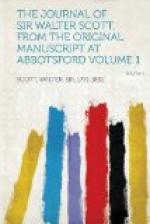June 15.—This being the day long since appointed for our cruise to Fife, Thomas Thomson, Sir A. Ferguson, Will Clerk, and I, set off with Miss Adam, and made our journey successfully to Charlton, where met Lord Chief-Baron and Lord Chief-Commissioner, all in the humour to be happy, though time is telling with us all. Our good-natured host, Mr. A. Thomson, his wife, and his good-looking daughters, received us most kindly, and the conversation took its old roll, in spite of woes and infirmities. Charlton is a good house, in the midst of highly-cultivated land, and immediately surrounded with gardens and parterres, together with plantations, partly in the old, partly in the new, taste; I like it very much; though, as a residence, it is perhaps a little too much finished. Not even a bit of bog to amuse one, as Mr. Elphinstone said.
June 16.—This day we went off in a body to St. Andrews, which Thomas Thomson had never seen. On the road beyond Charlton saw a small cottage said to have been the heritable appanage of a family called the Keays [?]. He had a right to feed his horse for a certain time on the adjoining pasture. This functionary was sent to Falkland with the fish for the royal table. The ruins at St. Andrews have been lately cleared out. They had been chiefly magnificent from their size—not their extent of ornament. I did not go up to St. Rule’s Tower as on former occasions; this is a falling off, for when before did I remain sitting below when there was a steeple to be ascended? But the rheumatism has begun to change that vein for some time past, though I think this is the first decided sign of acquiescence in my lot. I sat down on a grave-stone, and recollected the first visit I made to St. Andrews, now thirty-four years ago. What changes in my feeling and my fortune have since then taken place! some for the better, many for the worse. I remembered the name I then carved in Runic characters on the turf beside the castle-gate, and I asked why it should still agitate my heart. But my friends came down from the tower, and the foolish idea was chased away.[531]
June 17.—Lounged about while the good family went to church. The day is rather cold and disposed to rain. The papers say that the Corn Bill is given up in consequence of the Duke of Wellington having carried the amendment in the House of Lords. All the party here—Sir A.F. perhaps excepted—are Ministerialists on the present double bottom. They say the names of Whig and Tory are now to exist no longer. Why have they existed at all?
In the forenoon we went off to explore the environs; we visited two ancient manor-houses, those of Elie and Balcaskie. Large roomy mansions, with good apartments, two or three good portraits, and a collection of most extraordinary frights, prodigiously like the mistresses of King George I., who “came for all the goods and chattels” of old England. There are at Elie House two most ferocious-looking




